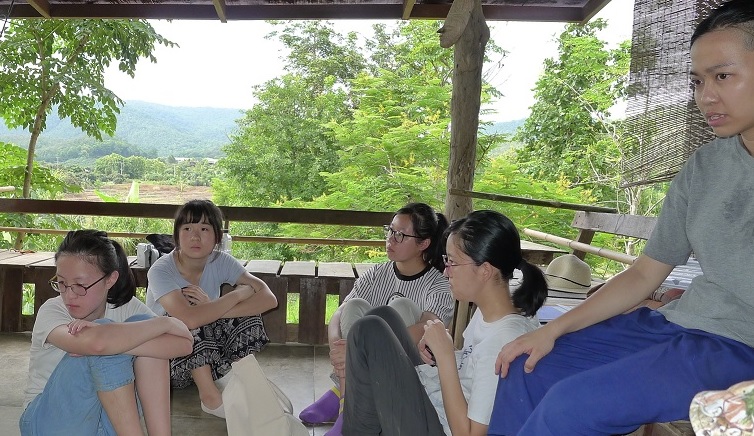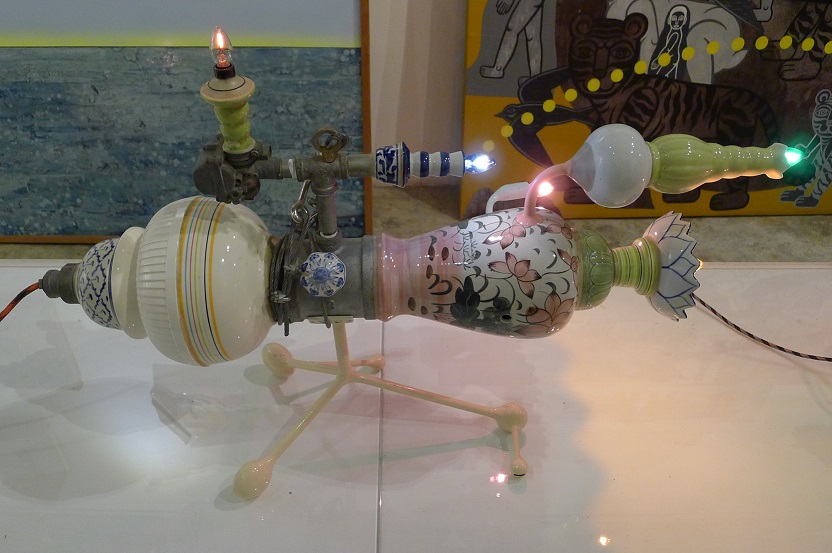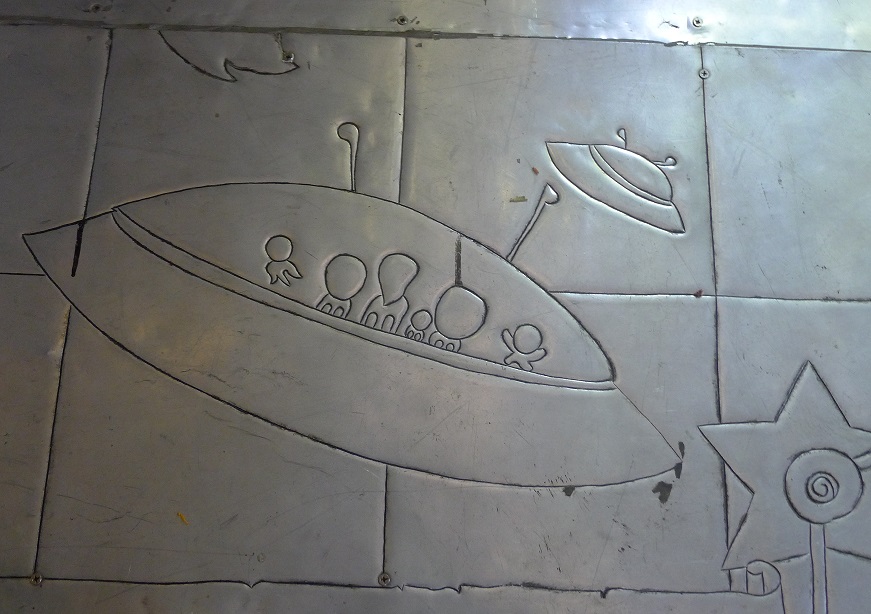新/另類藝術空間
- 天台塾在太空船與有機大米之間的溶洞救援行動 | A Cave Rescue Amidst Spaceships & Organic Rice Cultivation
約翰百德 (John BATTEN)
at 11:45am on 16th July 2018



圖片說明 Captions:
1. Pun Pun 有機農莊學習種籽的知識。Learning about seeds at Pun Pun Organic Farm.
2. Torlap Larpjaroensook的太空船。Torlap Larpjaroensook's spaceship.
3. 清邁銀寺的太空船圖像。Spaceship image at Chiang Mai's Silver Temple.
(Please scroll down for English version)
我原本打算在本週繼續討論粉嶺哥爾夫球會和球會未來管理的事。然而,我在泰國期間,碰巧是遇上了發現「野豬」少年足球隊和教練在清萊附近溶洞被困,以及他們後來在2018年7月10日成功被營救的事件。這段新聞在世界各地的媒體獲鋪天蓋地式的報道,結果是真正的「好消息」。
天台塾是促進香港和其他亞洲國家藝術交流的本地民間組織,該會舉辦了一個考察和藝術教育計劃,參加者包括藝術家、學生和香港藝壇成員,我也是其中一位。這項計劃獲民政事務局資助,是香港藝術家與東南亞鄰國同業少有的交流活動,特別是自1997年以來,藝術交流的焦點主要落在與中國內地之間。
我們7月2日下午到達清邁,約在午夜,首批潛水員找到足球隊。那夜,我和很多泰國人一樣看著泰國電視台的報道,對於找回這群男孩感到既欣慰又緊張。接下來的9天,由找到男子至成功把他們救出溶洞的這段時間,我們在考察計劃中完成了密集的研究和探訪,計劃的焦點是健康的另類生活和種植稻米,同時探討泰國的當代藝術生態。活動進行期間,背景一直傳來關於營教少年的新聞,但是,奇怪地,我們沒有和遇到的當地人討論太多。我想,我們都只是泰國的訪客,並不屬於他們的日常生活節奏,也不在學校、工作間與朋友聚會等日常社交對話與活動地點之內。你會發現,真正瞭解一個地方的「宏觀」意念,最好是「正常」的日常工作和社交活動時進行。然而,要獲得個人領會,或對一個地方的「微觀」看法,只要簡單地走出旅客酒店,還有字如其義地弄髒雙手也可實現。
在為期四天的旅程中,我們有一天開車前往清邁北面的Pun Pun 有機農莊,那天主要在這裡渡過。我們租用的小貨車停在塵土飛揚的路上。下車後,我們步行了約一公里,到達一個被小丘環抱的翠綠山谷(和香港的郊區不無相似),再到達Pun Pun的入口大閘。我們一行數人面上潔淨、清新,好像一起進入夏令營一樣,令我想起韋斯.安德森的電影《小學雞走私記》中的一幕。在農莊上,我們由Sheena,她先生Krit還有Pai當嚮導。Sheena帶我們參觀農莊各處,讓我們熟悉農莊上的活動,還有這裡種植的植物、水果和蔬菜。她向我講解如何耕種和為土壤補充養份––把牛糞肥料和收割後的農作物再次埋進土中。這裡沒有使用殺蟲藥:可能吃掉農作物的昆蟲,由其他昆蟲和雀鳥天然控制。農莊鼓勵天然平衡,讓大自然保護農作物。Pai為眾人介紹如何製作天然肥皂,然後我們共享了一頓農莊午飯。到了下午,我們在稻田裡耕作,在Krit的指導下播種。我們的隊員中,有些是第一次參與種植,讓雙足沾上泥濘。回到清邁前,我們還學習了一些關於種籽和播種的知識, 以及大型農業公司如何壟斷了種籽的銷售和使用,還有它們如何限制世界各地農民可以種植的蔬菜種類:這是一個不可持續的情況,並將會令很多可供進食植物從此消失。道別後,我們懷著愉快的心情,沿著來時的小石路 步出Pun Pun農莊,有點像《小學雞走私記》中的陣營,而Pai則騎著她的電單車從後追上,為我們送上最後的小禮物,真窩心!
一小時後,我們回到清邁,然後駕車前往Gallery Seescape與其他工作人員和藝術家會面,並共進晚餐。畫廊東主是藝術家Torlap Larpjaroensook,而他的混合媒體雕塑則以集合的陶瓷花瓶和燈製成。這些雕塑很像太空船,是為記念他的祖母而創作的。他的詩作《送媽媽上月球》解釋了這件作品的背景:
「從前,一艘太空船發射到月球上。
強大國家自豪的成就,把人類帶上太空。
我思考記憶之中太空船和月球之間的關係。
當俄羅斯與美國把火箭送上太空,
他們帶著全世界最傑出的創意。
同一時間,我祖母不斷注視月球。
我記得祖母
她不斷以花瓶插花
向神祇與大自然奉獻。
我們手牽著手上月球。
我的靈魂希望守護這段記憶。
似乎,這艘太空船
將發出發尋找過去。」
在旁邊主展廳中,是一個油畫展覽,包括多幅畫有高速公路、閃閃燈光和色彩的風景畫,是曼谷藝術家Amanaj Wachirasut的作品。他的靈感來自泰國作家 Hem Vejchakorn鬼故事Mogwai的音樂,還有大衛.連治和添.布頓的電影。
如果那天的開始是《小學雞走私記》的幻想,那麼這些畫作就像大衛.連治的科幻風神秘作品《失憶大道》一樣為今天寫上句號。
在清邁廣闊的星空中,我們可以很容易便把太空船想像出來。有人說太空船可能已經到訪過。翌日,我們幾個成員探訪了清邁的銀寺,在寺廟地上以銀刻上太空船!我們那天下午坐飛機回到曼谷。
...與此同時,經過近三星期在陰暗無光的清萊溶洞的日子,少年足球隊全部安全獲救。毫無疑問,他們在強光中會貶眼,也會感到一點點陌生。
參考資料:
www.rooftopinstitute.org
www.punpunthailand.org
原文刊於《明報周刊》,2018年7月21日
A Cave Rescue Amidst Spaceships & Organic Rice Cultivation
by John Batten
I intended to write more about the Fanling golf courses and their future management this week. However, a trip to Thailand exactly spanned the discovery of the ‘Wild Boars’ football team and their coach and rescue from a cave near Chiang Rai on 10 July 2018. The story had blanket media coverage throughout the world and was a genuine ‘good news’ event.
I was one of a group of artists, students, and members of Hong Kong’s art community on a fact-finding and art education programme organized by Rooftop Institute, a Hong Kong community organization that promotes art exchanges between our city and other Asian countries. The programme is funded by the Home Affairs Bureau and is a rare interaction by Hong Kong artists with our Southeast Asian neighbours, where the focus for art exchange since 1997 has predominantly been towards the mainland.
We arrived in Chiang Mai on the afternoon of 2 July and at around midnight the first divers found the football team. I watched Thai television, like most people in the country that night, fascinated and excited by the boys’ remarkable discovery. Over the next nine days – the time-span from the boys’ discovery to rescue out of the cave – we undertook an intensive study and visiting programme with a focus on healthy alternative living and the growing and cultivation of rice alongside enquiries into the Thai contemporary art scene. Always in the background was news about the pending rescue of the boys, but – strangely – we had few conversations about it with the many people we met. I suppose we were, after all, mere visitors to Thailand and outside the rhythms of daily living and the usual places of social conversation and activity: the school, the work place, meeting friends etc. You realize that truly understanding the ‘macro’ ideas of a place is best when doing ‘normal’ daily tasks and social activity. However, personal insight or a ‘micro’ view of a place can certainly be gained by simply getting out of a tourist hotel and literally getting your hands dirty.
On the fourth day of our trip we drove north of Chiang Mai to Pun Pun Organic Farm - where we spent most of the day. Our hire van dropped us off at a dusty road and we walked a kilometre up a green valley surrounded by hills (not unlike Hong Kong's countryside) to Pun Pun’s entry gate. Our clean fresh-faced group looked like we were entering summer camp, a movie-scene from Wes Anderson's Moonrise Kingdom. On the farm we were hosted by Sheena, her husband Krit and Pai. Sheena walked us around the farm to familiarise us with the farm's activities and the plants, fruit and vegetables grown. She explained how they were cultivated and the soil renourished - manure from cows and crops that are ploughed back into the soil. No insecticides are used; the insects that may eat the crops are kept in check by other insects and birds - the farm encourages a natural balance, so nature protects the crops. Pai showed everyone how to make natural soap and then we had a communal organic meal. In the afternoon we tilled a paddy field and sowed some rice under Krit's instruction - for some of us it was the first time to garden and get our feet muddy. Before returning to Chiang Mai, we learned about seeds and seeding and how large agricultural companies are monopolising the sale and use of seeds and intentionally restrict the varieties of vegetables that farmers grow around the world: this is an unsustainable situation and will be the demise of many varieties of edible plants. After saying good-bye, we happily walked out of Pun Pun along the gravel road in a loose Moonrise Kingdom formation and then Pai chased us on her motor-bike to give a final gift - lovely!
An hour later we were back in Chiang Mai - and then drove to Gallery Seescape to meet staff and artists and have dinner together. The owner of the gallery is artist Torlap Larpjaroensook and his mixed media sculpture is made of assembled ceramic vases and lights. These sculptures resemble spaceships as a memory of his grandmother. His poem ''Send Mom to the Moon'' explains the background of this artwork:
"Once, a spacecraft was propelled onto the moon.
The proud achievement of a powerful country presenting humanity to space.
I am pondering the relationship, between a space craft and the moon to my memory.
When Russia and America sent rockets into space,
They carried the best innovations of the world.
At the same time my grandmother kept gazing at the moon.
I remember grandmother|
always arranging the vase of flowers
as devotion to spirits and nature.
We are going to the moon hand in hand.
My soul wish is to keep this memory.
It seems that this spaceship
will be launched to seek our past."
Next door, in the main gallery was a painting exhibition of landscape impressions of highways, flashes of light and colour by Bangkok artist Amanaj Wachirasut who was inspired by the music of Mogwai, the ghosts stories of Thai writer Hem Vejchakorn and the films of David Lynch and Tim Burton.
If the day started with the fantasy of Moonrise Kingdom, then these paintings ended it with the sci-fi tinged mystery of David Lynch's Mulholland Drive.
With it wide starry night sky, spaceships can easily be imagined in the Chiang Mai air. There is a suggestion that they could have visited: the next day some of us visited Chiang Mai’s Silver Temple and etched in silver on the temple floor were spaceships! That afternoon we flew to Bangkok.
...Meanwhile, after nearly three weeks in the darkness of a Chiang Rai cave, the rescued football team emerged safely, no doubt blinking in the brightness and also feeling a little bit alien.
Link for further info:
www.rooftopinstitute.org
www.punpunthailand.org
This article was originally published in Ming Pao Weekly on 21 July 2018 and translated by Aulina Chan.
